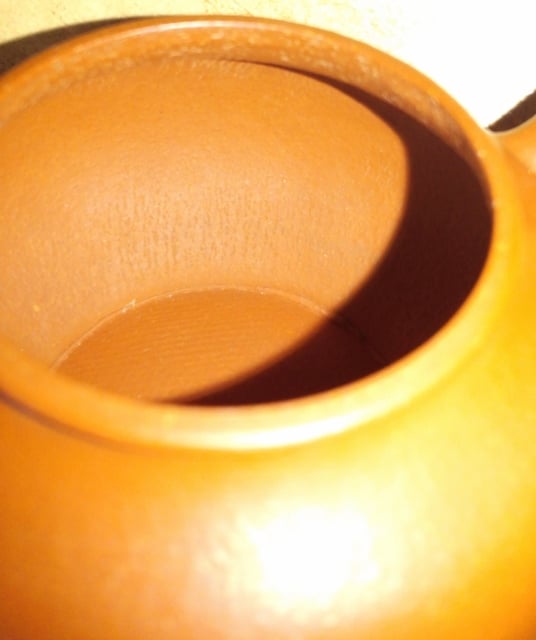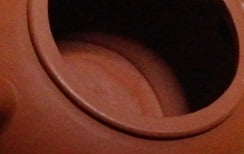Mar 20th, '14, 07:37
Posts: 1885
Joined: Mar 22nd, '08, 22:26
Location: Yixing
by chrl42 » Mar 20th, '14, 07:37
Tead Off wrote:chrl42 wrote:Tead Off wrote:chrl42 wrote:It's very hard to describe, but there is a liveliness in hand-made pots...words can't deliver those traits 100%. There are joint lines, in the back or front, between wall and bottom etc
In my understanding, there can be joint lines in both handmade and half-handmade pots. This will depend on the potter's careful finishing along with the help of the fire. Half-handmade are made in the same way that 100% handmades are except the various slabs of clay are fashioned in molds and will be the exact same size in the case of half-handmades. The potter then shapes the clay, joins, and finishes the various seams the same way that handmades are.
The joint lines in half hand-made pots will be removed while using moulds.
That's why some potters stamp a seal on the spot that later to become a wall of Yixing. To show it was hand-made.
I think there is a
huge difference between the level of hand-making and half hand-making. The former is highly an artistic field and the price speaks for it...
In my understanding, they will be removed in both cases. Some do a better job than others. I have seen many handmade pots without joint lines.
The stamping of a seal does nothing except identify a potter or studio. They can be done on both methods.
There is a level of handmade that is indeed noticeably higher quality, but you cannot say that
all handmades exhibit this.
..hand-made pots without joint-lines....that is quite rare.
But there ARE hand-made pots without joint-lines....pots made by perfectionists who removed joint-lines for clearance on purpose, (but if you say like it's normal those joint-lines are automatically removed, is totally wrong)....like He Dao-hong..whose pots now go for 100,000 usd....is that are you talking about?

Mar 20th, '14, 10:55
Posts: 4536
Joined: Apr 1st, '09, 00:48
Location: Bangkok
by Tead Off » Mar 20th, '14, 10:55
Think about this......If you are a potter and hand building teaware, would you leave joint marks showing on your work? I don't know of any craftsman that would do so. But, maybe there are some that I'm not aware of. It just doesn't make sense to me if I think about this in a logical way.
If a half-handmade pot is trying to pass itself off as a handmade pot, do they leave joint lines exposed? Why would half-handmade pots cover joint lines and handmade pots not cover them? Doesn't make any sense to me.
Mar 20th, '14, 11:05
Vendor Member
Posts: 399
Joined: Feb 2nd, '12, 03:03
Location: RSA
by SilentChaos » Mar 20th, '14, 11:05
Tead Off wrote:Think about this......If you are a potter and hand building teaware, would you leave joint marks showing on your work? I don't know of any craftsman that would do so. But, maybe there are some that I'm not aware of. It just doesn't make sense to me if I think about this in a logical way.
If a half-handmade pot is trying to pass itself off as a handmade pot, do they leave joint lines exposed? Why would half-handmade pots cover joint lines and handmade pots not cover them? Doesn't make any sense to me.
A lot of modern yixing potters, especially known ones, leave joint lines deliberately, SUPPOSEDLY as a sign of the pot being fully handmade.
Mar 20th, '14, 11:30
Posts: 1885
Joined: Mar 22nd, '08, 22:26
Location: Yixing
by chrl42 » Mar 20th, '14, 11:30
Tead Off wrote:Think about this......If you are a potter and hand building teaware, would you leave joint marks showing on your work? I don't know of any craftsman that would do so. But, maybe there are some that I'm not aware of. It just doesn't make sense to me if I think about this in a logical way.
If a half-handmade pot is trying to pass itself off as a handmade pot, do they leave joint lines exposed? Why would half-handmade pots cover joint lines and handmade pots not cover them? Doesn't make any sense to me.
They DO cover the joint lines, but covered marks are clearly left. They do that in order to make pots clear, as in trimming process, NOT in purpose of removing the joint lines. From what I know it's not possible to cover the joint lines 100% clear as if a half hand-made pots. The only exception is He Dao-hong.
Half hand-made pots joint lines are removed while using moulds as I've spoken earlier. What they imitate as passing off as hand-made, is to 'make up' joint lines....looks like the joint lines are rather sought-after on commercial pots

Mar 20th, '14, 12:14
Posts: 4536
Joined: Apr 1st, '09, 00:48
Location: Bangkok
by Tead Off » Mar 20th, '14, 12:14
The molds I've seen are flat and each end is open. When they shape the body, they have to join the two ends of the clay in a seam. This is the same process whether they are half or full handmade. Are you thinking of slip mold-made pots?
"Half-handmade is the assembly of machine-moulded pieces by hand with traditional tools. Many good teapots using Zisha clay are made in this way." This quote is from The Chinese Tea Shop.
How do you interpret this? If the parts are joined by traditional tools, they are the same whether 100% handmade or half-handmade. Both have to finish the teapot and smooth the lines where the joints are. I would think a lot of the joint marks are revealed after the firing is done. Maybe one of our potters could step in here and shed more light on this.
I've also tried to find an example of a mold used by Yixing potters but I cannot.
Mar 20th, '14, 12:35
Posts: 4536
Joined: Apr 1st, '09, 00:48
Location: Bangkok
by Tead Off » Mar 20th, '14, 12:35
SilentChaos wrote:Tead Off wrote:Think about this......If you are a potter and hand building teaware, would you leave joint marks showing on your work? I don't know of any craftsman that would do so. But, maybe there are some that I'm not aware of. It just doesn't make sense to me if I think about this in a logical way.
If a half-handmade pot is trying to pass itself off as a handmade pot, do they leave joint lines exposed? Why would half-handmade pots cover joint lines and handmade pots not cover them? Doesn't make any sense to me.
A lot of modern yixing potters, especially known ones, leave joint lines deliberately, SUPPOSEDLY as a sign of the pot being fully handmade.
No need to do this because in a handmade pot, you will see evidence of tool marks in shaping the handle and spout and often in the join areas of these two elements as well as elsewhere. Your example seems to indicate that this is a marketing tactic and I believe that could also be possible in this day and age.
Are there join lines in ROC and Qing/Ming pots?
Mar 20th, '14, 12:36
Posts: 4536
Joined: Apr 1st, '09, 00:48
Location: Bangkok
by Tead Off » Mar 20th, '14, 12:36
Thanks for posting this. Very interesting.
Mar 20th, '14, 12:42
Posts: 226
Joined: Aug 26th, '13, 18:29
by wert » Mar 20th, '14, 12:42
Tead Off wrote:SilentChaos wrote:Tead Off wrote:Think about this......If you are a potter and hand building teaware, would you leave joint marks showing on your work? I don't know of any craftsman that would do so. But, maybe there are some that I'm not aware of. It just doesn't make sense to me if I think about this in a logical way.
If a half-handmade pot is trying to pass itself off as a handmade pot, do they leave joint lines exposed? Why would half-handmade pots cover joint lines and handmade pots not cover them? Doesn't make any sense to me.
A lot of modern yixing potters, especially known ones, leave joint lines deliberately, SUPPOSEDLY as a sign of the pot being fully handmade.
No need to do this because in a handmade pot, you will see evidence of tool marks in shaping the handle and spout and often in the join areas of these two elements as well as elsewhere. Your example seems to indicate that this is a marketing tactic and I believe that could also be possible in this day and age.
Are there join lines in ROC and Qing/Ming pots?
The pot I shown is a perfect example of “very purposely showing old methods". During late qing/roc, joint line at the bottom is very often left unattended.
Mar 20th, '14, 12:52
Posts: 1657
Joined: Sep 2nd, '13, 03:22
Location: in your tea closet
Been thanked: 1 time
by kyarazen » Mar 20th, '14, 12:52
shrinking pots anyone?

Mar 20th, '14, 13:31
Posts: 214
Joined: Mar 28th, '11, 14:14
by Saladin » Mar 20th, '14, 13:31
Mar 20th, '14, 13:38
Posts: 4536
Joined: Apr 1st, '09, 00:48
Location: Bangkok
by Tead Off » Mar 20th, '14, 13:38
wert wrote:Tead Off wrote:SilentChaos wrote:Tead Off wrote:Think about this......If you are a potter and hand building teaware, would you leave joint marks showing on your work? I don't know of any craftsman that would do so. But, maybe there are some that I'm not aware of. It just doesn't make sense to me if I think about this in a logical way.
If a half-handmade pot is trying to pass itself off as a handmade pot, do they leave joint lines exposed? Why would half-handmade pots cover joint lines and handmade pots not cover them? Doesn't make any sense to me.
A lot of modern yixing potters, especially known ones, leave joint lines deliberately, SUPPOSEDLY as a sign of the pot being fully handmade.
No need to do this because in a handmade pot, you will see evidence of tool marks in shaping the handle and spout and often in the join areas of these two elements as well as elsewhere. Your example seems to indicate that this is a marketing tactic and I believe that could also be possible in this day and age.
Are there join lines in ROC and Qing/Ming pots?
The pot I shown is a perfect example of “very purposely showing old methods". During late qing/roc, joint line at the bottom is very often left unattended.
Can you show an example?
Last edited by
Tead Off on Mar 20th, '14, 13:39, edited 1 time in total.
Mar 20th, '14, 13:38
Posts: 702
Joined: Sep 4th, '10, 18:25
Been thanked: 1 time
by the_economist » Mar 20th, '14, 13:38
kyarazen wrote:shrinking pots anyone?

Pretty pot!
Mar 20th, '14, 13:47
Posts: 226
Joined: Aug 26th, '13, 18:29
by wert » Mar 20th, '14, 13:47
kyarazen wrote:shrinking pots anyone?


- CAM02210 (536x640).jpg (28.07 KiB) Viewed 844 times
Mar 20th, '14, 14:06
Posts: 226
Joined: Aug 26th, '13, 18:29
by wert » Mar 20th, '14, 14:06
Tead Off wrote:
Can you show an example?

- joint.jpg (4.92 KiB) Viewed 840 times
